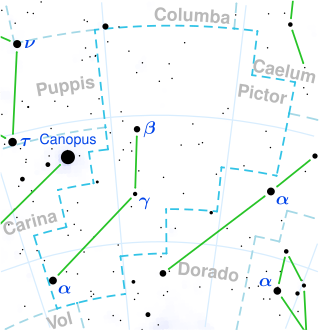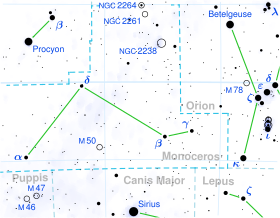
μ Sculptoris, Latinized as Mu Sculptoris, is a solitary, orange-hued star in the southern constellation of Sculptor. It is visible to the naked eye as a dim point of light with an apparent visual magnitude of +5.30. This star is located approximately 291 light years from the Sun based on parallax, and it is drifting further away with a radial velocity of +16 km/s.

4 Sagittarii is a suspected astrometric binary star system in the zodiac constellation of Sagittarius, located approximately 390 light years away based on parallax. It is visible to the naked eye as a faint, blue-white hued star with an apparent visual magnitude of 4.74, The system is moving closer to the Earth with a heliocentric radial velocity of −18 km/s.

Epsilon Microscopii, Latinized from ε Microscopii, is a single, white-hued star in the southern constellationof Microscopium. It is faintly visible to the naked eye with an apparent visual magnitude of 4.71. The annual parallax shift of the star is 19.7054 mas as measured from Earth, which yields a distance estimate of around 166 light years. It is moving further from the Sun with a radial velocity of +7 km/s.

17 Monocerotis is a single star located around 490 light years away from the Sun in the equatorial constellation of Monoceros. It is visible to the naked eye as a faint, orange-hued star with an apparent visual magnitude of 4.77. The star is moving away from the Earth with a heliocentric radial velocity of +46 km/s.

HD 102839 is a class G6Ib star in the constellation Musca. Its apparent magnitude is 4.98 and it is approximately 1,550 light years away from Earth based on parallax.

71 Ophiuchi is a single star in the equatorial constellation of Ophiuchus. It is visible to the naked eye as a faint, yellow-hued point of light with an apparent visual magnitude of 4.64. The star is located approximately 273 light years away from the Sun based on parallax, and is moving closer with a radial velocity of −3 km/s.

31 Orionis is a binary star system in the equatorial constellation of Orion, located near the bright star Mintaka. It is visible to the naked eye as a faint, orange-hued point of light with a baseline apparent visual magnitude of 4.71. The distance to this system is approximately 490 light years away based on parallax, and it is drifting further away with a mean radial velocity of +6 km/s.

2 Pegasi is a single star in the constellation Pegasus, located approximately 394 light years away from the Sun based on parallax. It is visible to the naked eye as a faint, red-hued star with an apparent visual magnitude of 4.52. The object is moving closer to the Earth with a heliocentric radial velocity of −19 km/s. It has a magnitude 12.7 visual companion, designated component B, at an angular separation of 30.4″.

17 Persei is a single star in the northern constellation of Perseus, located about 390 light years away from the Sun. It is visible to the naked eye as a faint, orange-hued star with an apparent visual magnitude of 4.53. This object is moving further from the Earth at a heliocentric radial velocity of +13 km/s.

HD 18970 is a class G9.5III star in the constellation Perseus. Its apparent magnitude is 4.77 and it is approximately 211 light years away based on parallax.

24 Persei is a star in the northern constellation of Perseus, located around 337 light years from the Sun. It is visible to the naked eye as a faint, orange-hued star with an apparent visual magnitude of 4.94. The object is moving closer to the Earth with a heliocentric radial velocity of −37 km/s.

QZ Puppis is a class B2.5V star in the constellation Puppis. Its apparent magnitude is 4.5 and it is approximately 650 light years away based on parallax.

HD 65810 is a class A2V star in the constellation Puppis. Its apparent magnitude is 4.61 and it is approximately 241 light years away based on parallax.

HD 59890 is a class G3Ib yellow supergiant star in the constellation Puppis. Its apparent magnitude is 4.65 and it is approximately 1,360 light years away based on parallax.

HD 63744 is a class K0III star in the constellation Puppis. Its apparent magnitude is 4.71 and it is approximately 232 light years away based on parallax.

HD 50235 is a class K5III star located approximately 811 light years away, in the constellation Puppis. Its apparent magnitude is 4.99. HD 50235 made its closest approach to the Sun 7.8 million years ago, at the distance of 137 light years, during which it had an apparent magnitude of 1.13.

HD 167818 is a class K3II star in the constellation Sagittarius. Its apparent magnitude is 4.66 and it is approximately 760 light years away based on parallax.
HD 189831 is a class K5III star in the constellation Sagittarius. Its apparent magnitude is 4.77 and it is approximately 366 light years away based on parallax.

31 Persei is a single star in the northern constellation of Perseus. It is visible to the naked eye as a dim, blue-white hued point of light with an apparent visual magnitude of 5.05. This star is located around 172 parsecs (560 ly) away from the Sun, and it is drifting closer with a radial velocity of −1.6 km/s. It is likely a member of the Alpha Persei Cluster.

HD 42540, also known as HR 2196, is a giant star in the constellation Pictor. A class K2-3III orange giant, its apparent magnitude is 5.04 and it is approximately 389 light years away based on parallax.











